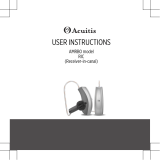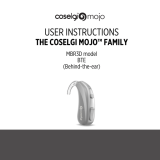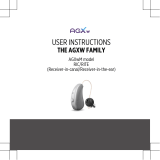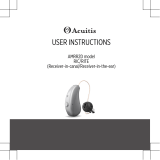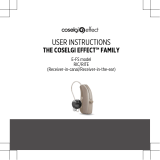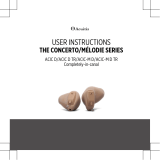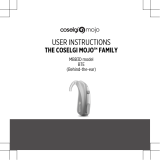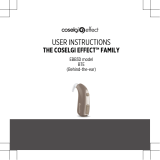
USER INSTRUCTIONS
THE WIDEX MAGNIFY™ FAMILY
MBR3D model
BTE
(Behind-the-ear)

YOUR HEARING AID
(To be filled out by your hearing care professional)
This is a list of possible programs for your hearing aid.
For further information on the use of these programs, see Customization.
Your hearing aid programs:
PROGRAMS AUDIBILITY EXTENDER
Universal
Quiet
Comfort
Transport
Urban
Impact
Party
Social
Music
T
M+T
2

SPECIAL PROGRAMS AUDIBILITY EXTENDER
Zen/Relax
Phone
SMARTTOGGLE PROGRAMS AUDIBILITY EXTENDER
Zen+/Relax+
The program names in the table are the default names. If you have chosen
to use some of the other names available, write the new names in the table.
That way you will always know which programs you have in your hearing
aids.
Read the instructions
Carefully read the user instructions in this booklet and in the booklet
"Ear-sets for Widex hearing aids" before you start using your hearing aid.
You should also read the user instructions for the charger.
Sound streaming and wireless control
The hearing aid allows sound streaming and direct wireless control from
smartphones and other devices via DEX. For more help and information
contact your hearing care professional or visit: www.widex.com.
The hearing aid works wirelessly with the MAGNIFY app. We take no
responsibility if the hearing aid is used with any third party app or if the app
is used with any other device. Read more about the app in the booklet.
3

CONTENTS
IMPORTANT SAFETY INFORMATION.......................................................... 6
YOUR HEARING AID...................................................................................9
Welcome...........................................................................................................9
Your hearing aid at a glance..................................................................... 10
CONDITIONS FOR USE...............................................................................11
Indications for use...........................................................................................11
Hearing aids with rechargeable batteries.................................................11
Intended use.................................................................................................... 11
Charging.......................................................................................................... 12
Use time and charging time..........................................................................12
Operating and charging conditions............................................................. 14
Storage and transport conditions.................................................................15
DAILY USE................................................................................................ 17
Turning the hearing aid on and off...............................................................17
Putting on and removing the hearing aid...................................................18
CUSTOMIZATION...................................................................................... 19
Programs.........................................................................................................19
The Zen program........................................................................................ 21
Sound and light indicator signals................................................................ 22
Lost partner ................................................................................................25
4

Sound and program adjustment................................................................. 26
Using a smartphone with your hearing aid................................................27
PAIRING WITH YOUR SMARTPHONE........................................................28
Connecting with your smartphone via Bluetooth .................................28
How to connect the hearing aid to the app............................................28
How to turn off the Bluetooth connection..............................................28
Compatibility with smartphones.................................................................29
CLEANING................................................................................................30
Tools................................................................................................................30
Widex CHARGE n CLEAN...............................................................................31
ACCESSORIES...........................................................................................32
TROUBLESHOOTING.................................................................................33
TRAVELLING ON AN AIRPLANE................................................................36
REGULATORY INFORMATION...................................................................37
FCC and ISED statements............................................................................. 37
EU directives...................................................................................................39
Directive 2014/53/EU................................................................................ 39
Information regarding disposal...............................................................40
SYMBOLS..................................................................................................41
5

IMPORTANT SAFETY INFORMATION
Read these pages carefully before you begin using your hearing aid.
Hearing aids and batteries can be dangerous if swallowed or used
improperly. Swallowing or improper use can result in severe injury
or even fatalities. In case of ingestion, contact your local emergency
number or hospital immediately.
Take your hearing aids out when you are not using them. This will help to
ventilate the ear canal and prevent ear infections.
Contact your doctor or hearing care professional immediately if you
suspect you may have an ear infection or an allergic reaction.
Contact your hearing care professional if the hearing aid doesn't feel
comfortable, or if it doesn't fit properly, causing irritation, redness or the
like.
Remove your hearing aids before showering, swimming or using a hair
dryer.
Do not wear your hearing aids when applying perfume, spray, gel, lotion
or cream.
Do not dry your hearing aid in a microwave oven – this will ruin it.
Never use other people’s hearing aids and never allow others to use
yours, as this could damage your hearing.
Never use your hearing aids in environments where there may be explo-
sive gases, such as in mines.
6

Keep hearing aids, their parts, accessories and batteries away from
children and mentally disabled people.
Never try to open or repair the hearing aid yourself. Contact your hearing
care professional if you need to have your hearing aid repaired.
Your hearing aids contain radio communication technology. Always ob-
serve the environment in which you are using them. If any restrictions
apply, you must take precautions to comply with these.
Your device has been designed to comply with international electromag-
netic compatibility standards. However, there is still the possibility that it
may cause interference with other electrical equipment. If you experience
interference, keep a distance to other electrical equipment.
Please note that streaming sound to your hearing aids at a high volume
can prevent you from hearing other important sounds such as alarms
and traffic noise. In such situations make sure to keep the volume of the
streamed sound at a suitable level.
Your hearing aid is very powerful and it can play sounds that exceed a
level of 132 dB. There may therefore be a risk of damaging your remaining
hearing.
Do not expose your hearing aids to extreme temperatures or high humid-
ity, and dry them quickly if they get wet or if you perspire heavily.
Do not use any kind of liquid or disinfectant to clean your hearing aid.
7

Clean and inspect your hearing aid every day after use to check that it is
not broken. If the hearing aid is damaged while you are wearing it and
small fragments are left in your ear canal, seek medical attention. Never
try to take out the fragments yourself.
8

YOUR HEARING AID
Welcome
Congratulations on your new hearing aid.
This hearing aid is powered by a rechargeable lithium-ion battery and must
be used with the charger model WPT202. The battery is built-in and you
cannot replace this.
We recommend that you use your hearing aid regularly, even if it takes
some time getting used to it. Infrequent users do not usually get the full
benefit of a hearing aid.
NOTE
Your hearing aid and its accessories may not look exactly as illustrated in this
booklet. We also reserve the right to make any changes we consider necessary.
9

Your hearing aid at a glance
The illustration shows your hearing aid without the ear-set. For further
information on the ear-set see the ear-set manual. The ear-set consists of a
tube and an ear-tip or earmould, and it is the part of your hearing aid that
you wear inside your ear.
3
4
2
1
7
5
6
1. Microphone opening
2. Program button / On/
off switch
3. Volume control
4. Light indicator
5. Hook
6. Identification plate
(model and serial
number)
7. Left/right identifica-
tion. Blue indicates
your left hearing aid,
while red is for your
right hearing aid.
Please note that the hook is fixed to the hearing aid
and should not be removed.
10

CONDITIONS FOR USE
Indications for use
The hearing aids are indicated for individuals older than 36 months with
a range of hearing loss from minimal (10 dB HL) to severe-to-profound
(105 dB HL) and all hearing loss configurations.
They are to be programmed by licensed hearing care professionals (audiol-
ogists, hearing aid specialists, otolaryngologists) who are trained in hearing
(re)habilitation.
Hearing aids with rechargeable batteries
Hearing aids with rechargeable batteries should NOT be used by children
younger than 36 months or mentally disabled people.
Intended use
The hearing aids are intended as air conduction amplification devices to
be used in everyday listening environments. The hearing aids may be
equipped with the Zen program, intended to provide a relaxing sound
background (i.e. music/noise source) for adults who desire to listen to such
a background in the quiet.
11

Charging
We recommend that you charge your hearing aid daily. This illustration
shows your charger at a glance:
4
2
2
1
1
3
1. Charging wells
2. Light indicators
3. Hinged cover
4. Micro USB port
For further information on how to charge your hearing aid, see the user
instructions for the charger.
Use time and charging time
Charging your hearing aid fully will take approximately 4 hours. If you
charge your hearing aid for half an hour, you have approximately 4 hours of
use.
When the hearing aid is fully charged, you can use it for at least 24 hours in
normal hearing environments before the next charge.
12

4 hours 24 hours
When you hear the battery alarm indicating low power, you will have
approximately 3-4 hours of normal use. The hearing aid turns off when the
battery power is critically low.
Hearing loss, sound environment and streaming are factors that affect the
estimated use time. For example, if you use the streaming service, you will
reduce the use time of the hearing aid.
13

Operating and charging conditions
Your hearing aid has been designed to operate in everyday situations, and
it works in environmental conditions that are comfortable for you. You
can wear your hearing aid during flights, but you should remove it before
showering, swimming and sleeping.
Operating conditions
Minimum Maximum
Temperature 0 °C (32 °F) 40 °C (104 °F)
Humidity 10% rH 95% rH
Atmospheric pressure 750 mbar 1060 mbar
Charging conditions
Minimum Maximum
Temperature 0 °C (32 °F) 30 °C (86 °F)
Humidity 10% rH 95% rH
14

Long-term storage when not in use
If you plan to not wear your hearing aid for a longer period of time, charge
it fully and store it in the end-user case you received with the hearing aid.
Remember to turn off the hearing aid before storage.
Every 6 months you will have to charge the hearing aid to avoid an
unrecoverable deep-discharge of the battery. A deep-discharged battery
can no longer be charged and has to be replaced. We would however
recommend recharging more frequently than every 6 months.
Storage and transport conditions
Your hearing aid is sensitive to extreme conditions such as high tempera-
tures. It should not be stored or transported in direct sunlight, but only
within the following conditions.
Storage conditions
Minimum Maximum
Temperature 10 °C (50 °F) 40 °C (104 °F)*
Humidity 20% rH 80% rH
*Recommended temperature is 10°C to 25°C.
Transport conditions
Minimum Maximum
Temperature -20 °C (-4 °F) 55 °C (131 °F)
15

Minimum Maximum
Humidity 10% rH 95% rH
You can find technical data sheets and additional information on your
hearing aids on https://global.widex.com.
16

DAILY USE
Turning the hearing aid on and off
You can turn the hearing aid on in two ways:
1. Press and hold the push button for a few seconds. After another few
seconds, the light indicator on the volume control will flash green and
the hearing aid will play a sound signal to indicate that it is on, unless
you have agreed with your hearing care professional to deactivate this
function.
2. Remove the hearing aid from the charger. It will turn on automatically
after a few seconds. The light indicator on the volume control will flash
green and the hearing aid will play a sound signal to indicate that the
hearing aid is on.
You can turn the hearing aid off in two ways:
1. Place the hearing aid in the charger and the charging starts.
2. Press and hold the push button for a few seconds. A final tone will
sound and the light indicator on the volume control will flash red.
17

Putting on and removing the hearing aid
Putting on the hearing aid
1
2
1. Insert the ear-set in the ear while holding the lower
part of the tube/earwire. Pulling the outer ear upwards
and backwards at the same time can be helpful.
2. Then place the hearing aid behind the ear. The hearing
aid should rest comfortably on the ear, close to your
head.
Your hearing aid can be fitted using different types of ear-sets. See the
separate ear-set manual for more information about your ear-set.
Removing the hearing aid
Start by removing the hearing aid from behind the
ear.
Then take the ear-set carefully out of the ear canal
while you hold the lower part of the tube/earwire.
18

CUSTOMIZATION
Programs
This is an overview of programs that you can select from. Ask your hearing
care professional for guidance.
PROGRAMS USE
Universal Automatic program with focus on optimum
sound in all situations
Quiet Special program for listening in quiet environ-
ments
Comfort Special program for listening in noisy environ-
ments
Transport For listening in situations with noise from cars,
trains, etc.
Impact Use this program if you prefer a clear and sharp
sound
Urban For listening in situations with changing sound
levels (in supermarkets, noisy workplaces or
the like)
Party For listening in situations with many people
talking at the same time
19

PROGRAMS USE
Social Use this program if you are in small social
gatherings, such as family dinners
Music For listening to music
T With this program you listen through the hear-
ing aid's telecoil, which allows you to listen
directly to the sound without background noise
(requires a teleloop system)
M+T This program is a combination of the hearing
aid's microphone and the telecoil. You listen
to the sound source, but can also hear other
sounds
SPECIAL PROGRAMS USE
Zen/Relax Plays tones or noise for a relaxing sound back-
ground. For more information, see "The Zen
program"
Phone This program is designed for listening to phone
conversations
20
Page is loading ...
Page is loading ...
Page is loading ...
Page is loading ...
Page is loading ...
Page is loading ...
Page is loading ...
Page is loading ...
Page is loading ...
Page is loading ...
Page is loading ...
Page is loading ...
Page is loading ...
Page is loading ...
Page is loading ...
Page is loading ...
Page is loading ...
Page is loading ...
Page is loading ...
Page is loading ...
Page is loading ...
Page is loading ...
Page is loading ...
Page is loading ...
/
